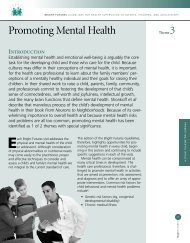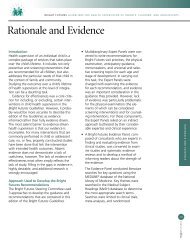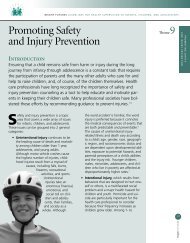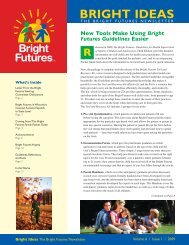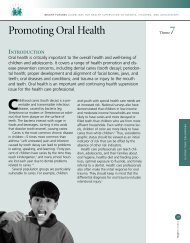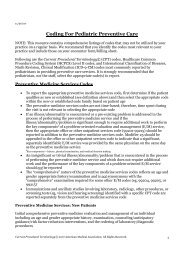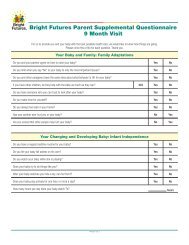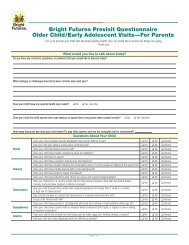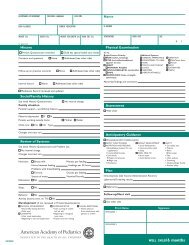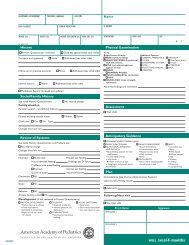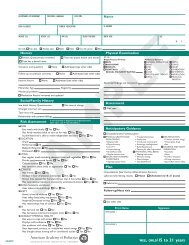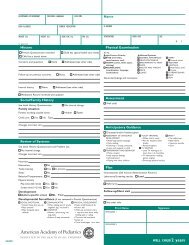POCKET GUIDE - Bright Futures - American Academy of Pediatrics
POCKET GUIDE - Bright Futures - American Academy of Pediatrics
POCKET GUIDE - Bright Futures - American Academy of Pediatrics
Create successful ePaper yourself
Turn your PDF publications into a flip-book with our unique Google optimized e-Paper software.
■ Describe what your child does during mealtimes. What<br />
do you do?<br />
■ What do you do if your child doesn’t like a particular food?<br />
■ Do you have equipment for feeding your child (cups, forks<br />
and spoons, a high chair, a booster seat)?<br />
■ Do you have any concerns about the food served to her<br />
when she is away from home?<br />
■ Are you concerned about having enough money to<br />
buy food?<br />
Screening and Assessment<br />
growth and Development<br />
■ Measure the child’s length or height and the child’s weight,<br />
and plot it on a standard growth chart. Deviation from<br />
expected growth patterns should be evaluated. This may be<br />
normal or may indicate a nutrition problem.<br />
■ Determine the child’s nutrition status and overall health<br />
using body mass index (BMi). Calculate the child’s BMi by<br />
dividing weight by square <strong>of</strong> height (kg/m2 ), or use a BMi<br />
wheel or calculator. Plot the child’s BMi and age on a BMifor-age<br />
growth chart to determine BMi percentile.<br />
■ evaluate the appearance <strong>of</strong> the child’s skin, hair, teeth,<br />
gums, tongue, and eyes.<br />
iron-Deficiency Anemia<br />
guidelines from the <strong>American</strong> <strong>Academy</strong> <strong>of</strong> <strong>Pediatrics</strong> (AAP)<br />
and the Centers for Disease Control and Prevention (CDC):<br />
Children Ages 12 to 18 Months<br />
■ screen children at about age 12 months and about age<br />
18 months. (AAP)<br />
■ screen children at high risk or those with known risk<br />
factors at ages 9 to 12 months and again 6 months later<br />
(ages 15–18 months). (CDC)<br />
— Children considered to be at high risk for irondeficiency<br />
anemia include<br />
▶ Children from families with low incomes<br />
▶ Children who are eligible for the special<br />
supplemental Nutrition Program for Women,<br />
infants, and Children (WiC)<br />
▶ Children who are migrants or recently arrived<br />
refugees<br />
▶ Children who are Mexican <strong>American</strong><br />
27<br />
<strong>Bright</strong> FUTURES<br />
Early Childhood



